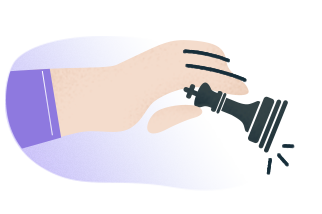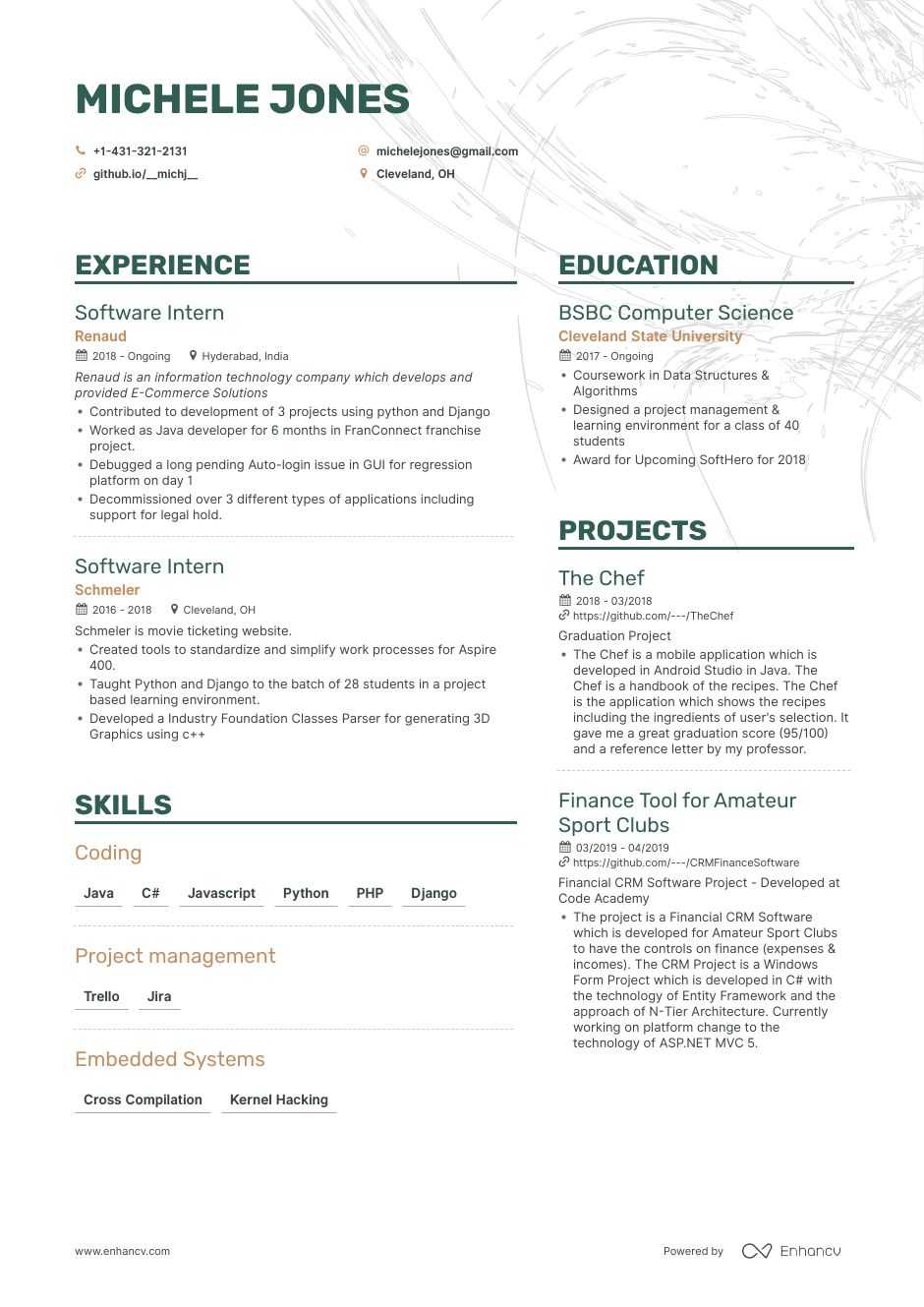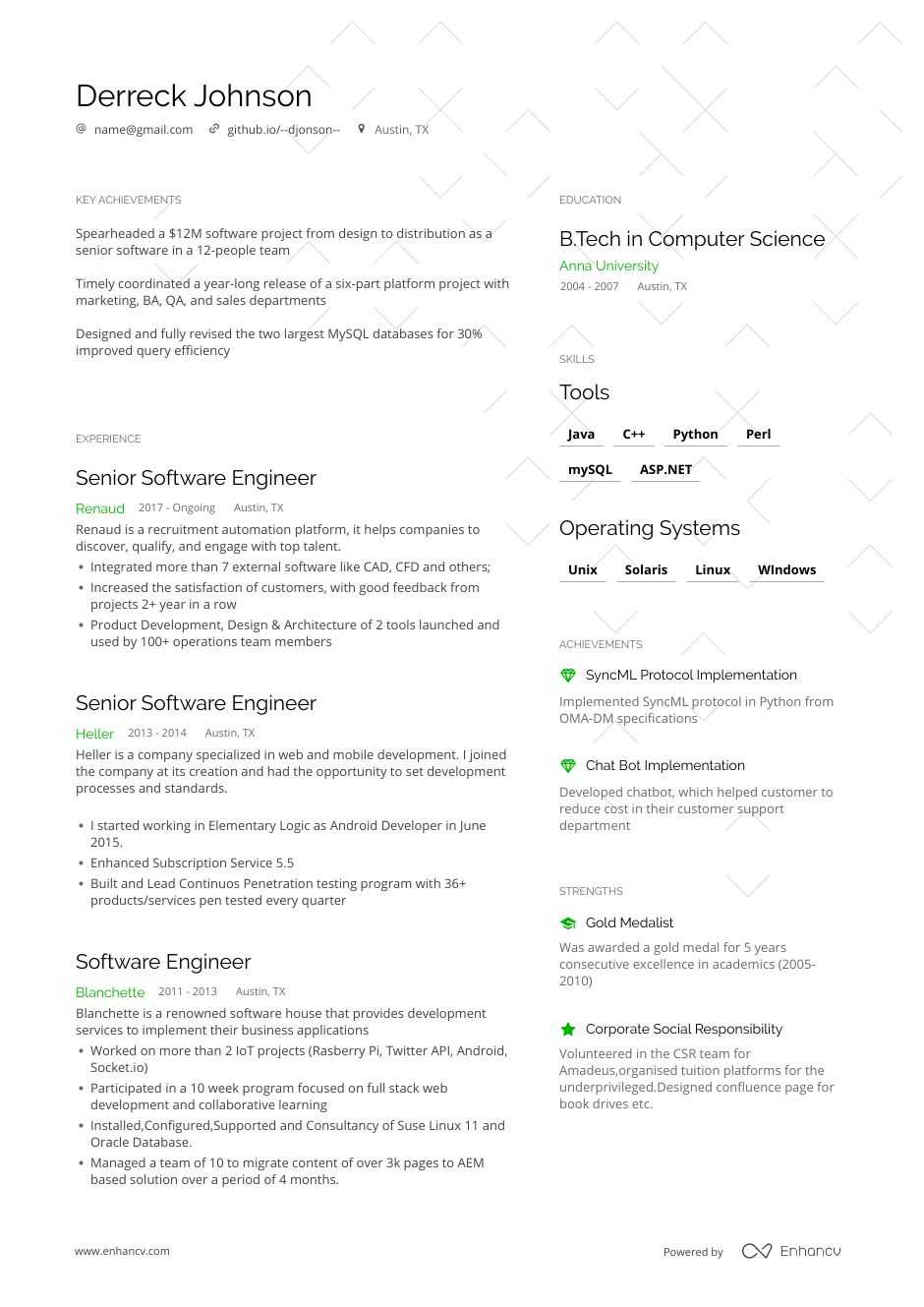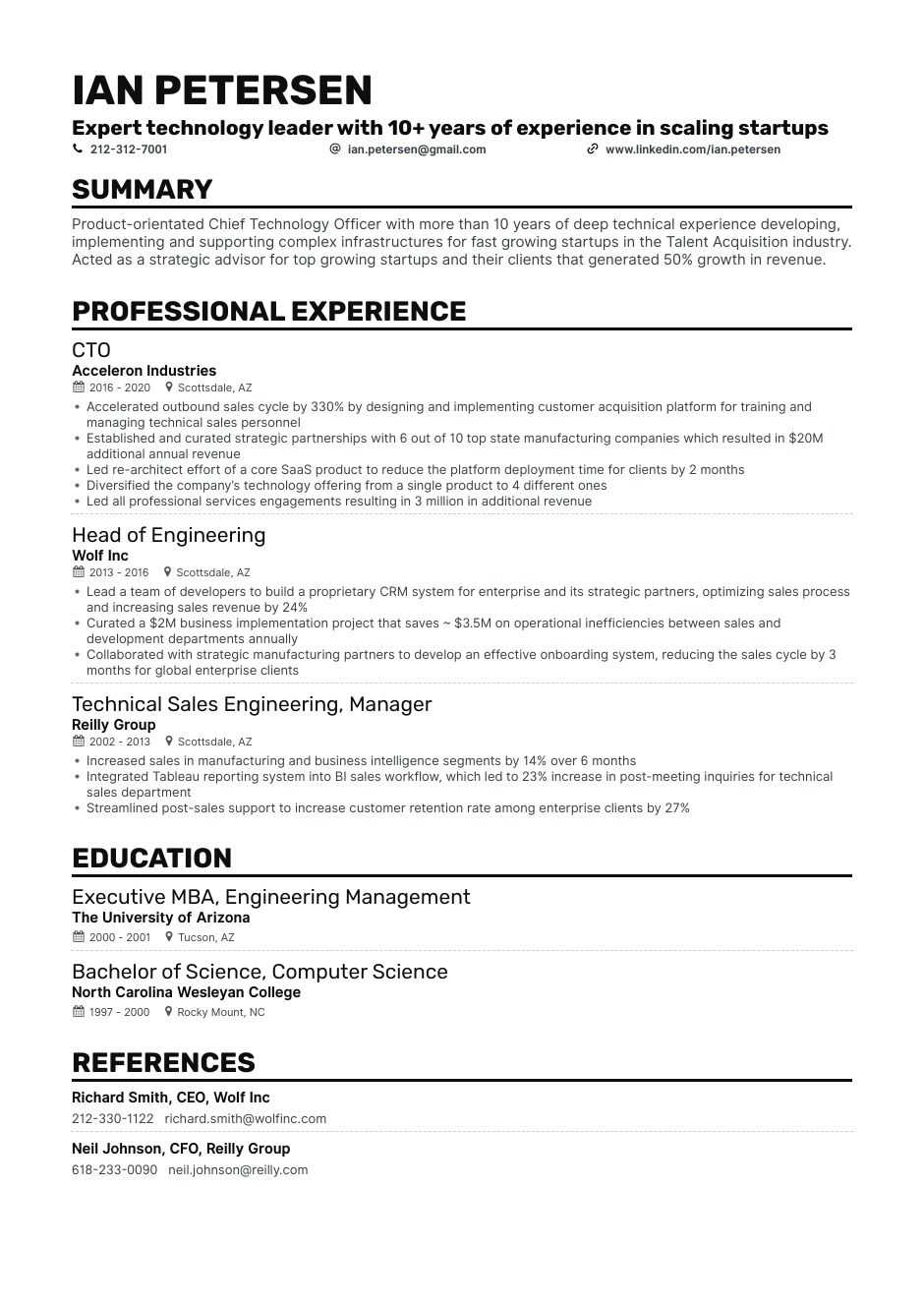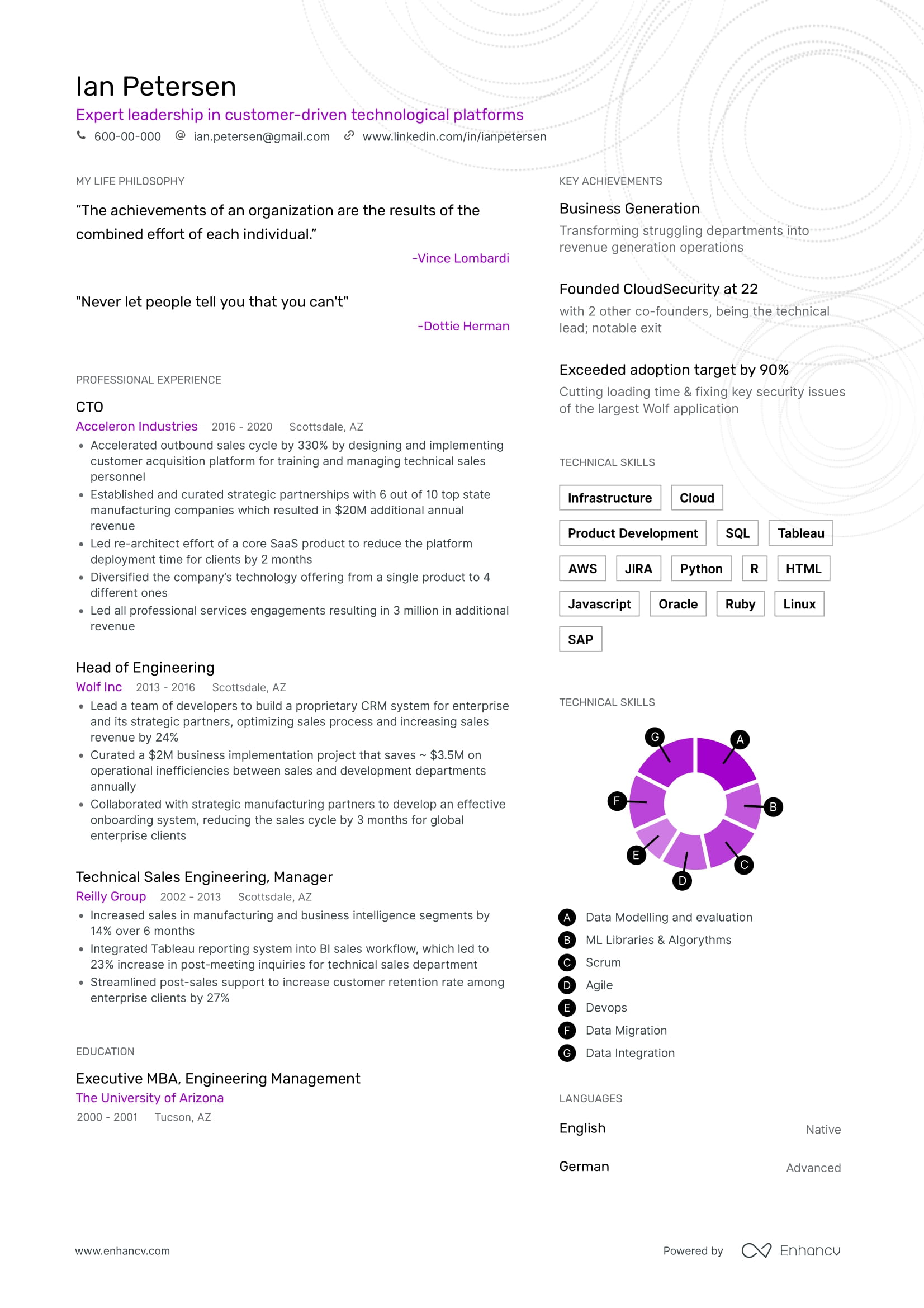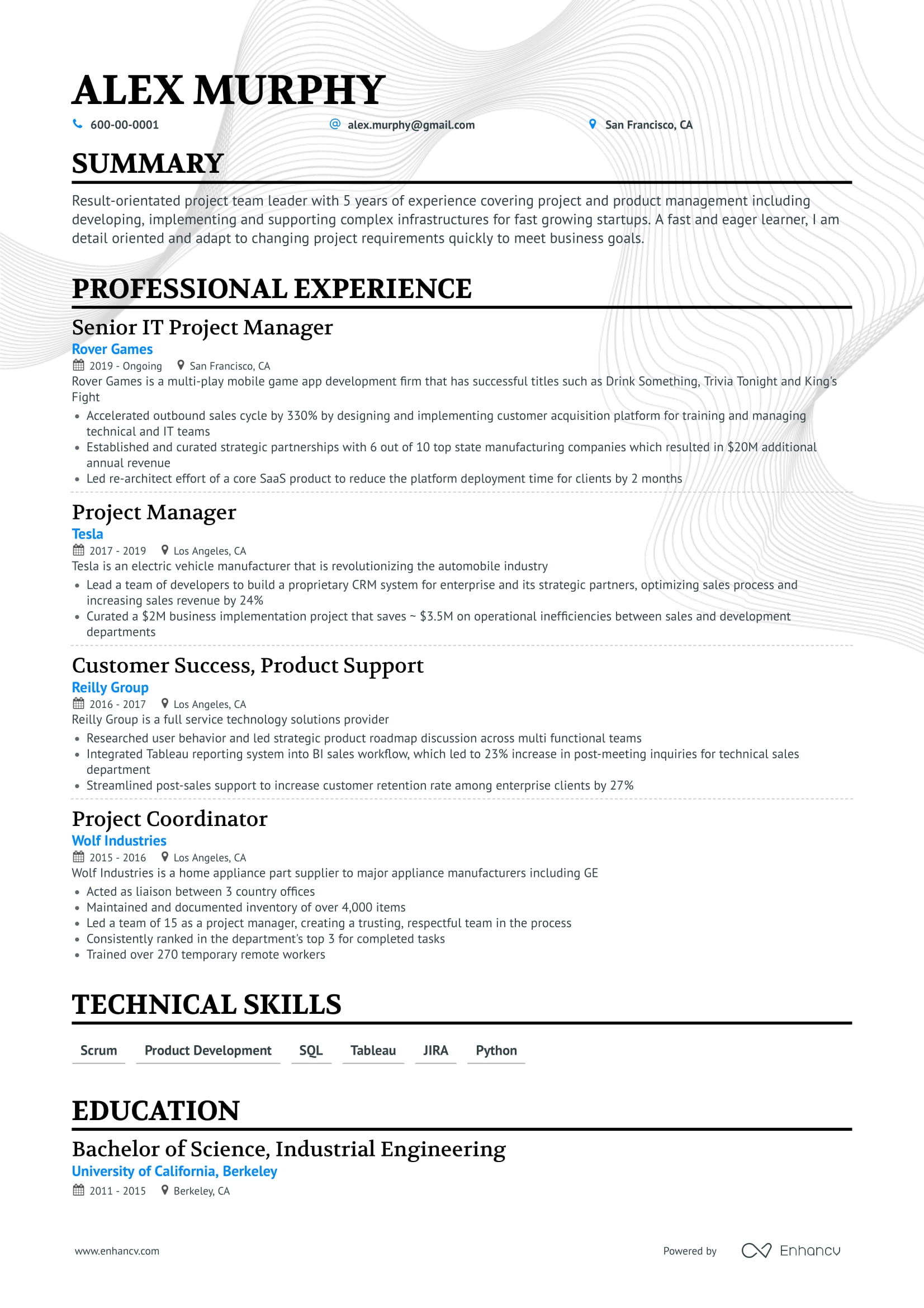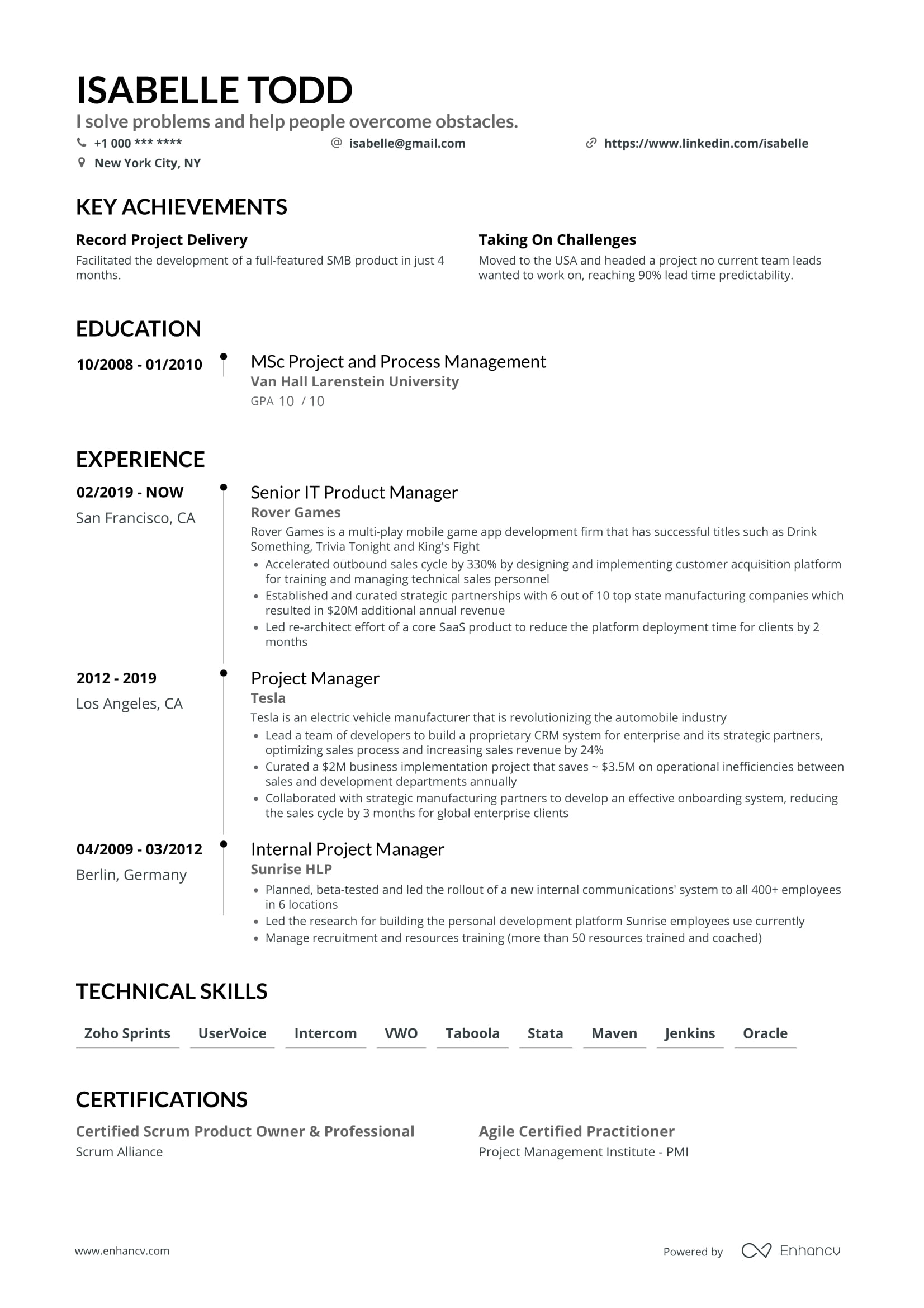Example Software Engineer Resume - Browse more resume templates and build a stand-out resume
Writing a software engineering resume feels tough. Even somewhat unnatural. “I know my code. I spent years perfecting my skill. What else do they want?“
But let’s take a recruiter’s side. “I have 250 resumes on my desk. They all know how to code. Who should I pick?”
In our experience, recruiters have a system they follow. Otherwise, reviewing that many resumes in a day would be impossible.
The good news is that we cracked their code. We learned how to write software engineer resumes that statistically land more interviews than others.
But don't be fooled. You have to put some work in.
In this guide, you’ll learn:
- How to make your software engineer resume convincing even for non-technical recruiters
- How to increase your chances of landing an interview with top tech companies
- How to properly format different sections of your resume to tell a coherent and engaging story that hiring managers will like
- How to land 9 out of 10 interviews, following our software engineer resume examples
- How to use resume templates to get your dream job
Software Engineer resume sample
Software Engineer resume samples
Entry Level Software Engineer Resume Example and Template
- Showcase real project experience. You’ll probably learn more about software development during the first 3 months at your first job than in 8 years at university.
That’s why technical and non-technical recruiters alike praise real project experience so much, as it shows you are comfortable in a production environment, can work with a team, and can follow guidelines.
Frame your experience around software projects. Side applications, open-source code contributions, even relevant Fiverr gigs give you an edge over inexperienced candidates.
Tip: Whenever you finish a software course or an internship, focus on the projects you completed rather than received praise, certifications, or abstract coursework labels.
- Be mindful of linking to your Github page. Your Github is a dark horse — you never know how it might play out in your hiring process. Some recruiters will look at it and make their mind, others will totally ignore it.Prepare for the worst. Imagine someone will go through your Github page. What will they see? A bunch of unneeded comments? An empty profile? It doesn’t matter if the code there was written 3 or 5 years ago — you will be judged today.
So put Github on your resume only if you deem it as your advantage. Otherwise, it might play against you.
Learn more practical advice with ourEntry-level Software Engineer Resume guide.
Mid Level Software Engineer Resume Example and Template
- Prove you are the perfect “workhorse”. It’s true that middle software engineers are the “workhorses” of the programming world. They deliver the most impact with routine code, optimize their workflows down to the letter, and have excellent coding habits.Highlight the following qualities in the context of your software projects to present yourself in the best light:
- ability to deliver huge amounts of work with less or zero supervision
- active collaboration with team members and team leads
- deep understanding of platforms and tools relevant to the target company tech stack
- Target resume to the company environment.Targeted resume, or tailoring your resume to the specific job description, is a highly effective technique for landing job interviews. But don’t just target your resume to the job description as often technical job descriptions are written by non-technical HR managers. Research target company blogs, LinkedIn profiles of its developers, and social media to learn more about the company’s tech environment and its current challenges. Use this information to frame your experience for maximum impact. While non-technical recruiters might skip such details, an experienced team lead will certainly not.
Senior Software Engineer Resume Example and Template
- Showcase your ability to guide and grow teams. Senior software engineers provide guidance, always figuring out what they can do to help the team members.When applying for senior positions, make sure your senior software engineering is focused on your team achievements and collaboration, rather than your individual highlights. As a bonus, check out the size of your target company’s software department and emphasize having experience with teams of similar sizes.
- Show your ability to solve company-level problems. Did your work have a tangible positive impact on the business you worked for? If you can show that on your resume, consider yourself a unicorn.Many software engineers are doing great things for the companies they work at, but proving their work consistently produces measurable business outcomes is a trait of a perfect leader. Frame parts of your experience using challenge - solution - business outcome framework to put a big dot on your dream company’s radar.
If you worry about how to feature many years of experience on your resume, check out ourResume Length: How Long Should a Resume Be in 2022 guide.
Looking for related Software Engineer resumes?
- Information Technology resume
- Web Developer resume
- JavaScript Developer resume
- Enterprise Architect resume
- Network Engineer resume
- Android Developer resume
- Angular Developer resume
- DevOps Engineer resume
- Director of Software Engineering resume
- Java Developer resume
- Software Architect resume
- Golang Developer resume
- Junior Java Developer resume
- Frond End Developer resume
- Full-Stack Developer resume
- Solutions Architect resume
- Web Designer resume
- PHP Developer resume
- NodeJS Developer resume
- Microservices resume
- Systems Analyst resume
How to Write a Software Engineer Resume That Gets Interviews
- Demonstrate real impact with finished projects
Simply stating that you “worked on a cloud-based application” gives a hiring manager neither indication of your abilities nor the level of your contribution.Also, any finished project is x10 times more credible than an unfinished one, and stating that you worked on something doesn’t mean you finished it. A finished project has outcomes.Bad example: worked on a cloud-based application
Good example: Spearheaded a $12M cloud-based application development from design to distribution as a senior software engineer in a 12-people team
More examples of that in the Experience section of this guide.
- Focus on the employer, not yourself.
A natural instinct of 99% inexperienced resume writers is to start selling yourself. “I can…” I work with [insert buzzword]…”, and “ I did…”Yes, in a way you are a product. But you don’t see “I drive people” on a BMW slogan. It’s “Sheer Driving Pleasure.”Bad example: Expert knowledge of Python librariesGood example: Reduced the loading time of a 10 million photo library by 68% by developing a preloading algorithm using Python’s SciPy library
More examples on that in the Summary, Experience, and Skills sections of this guide.
- Resume format does make a difference. But not in a way you might expect.
We’re not talking aboutfancy colors here or creative layouts. A smart layout guides the recruiter's attention to your best hits and produces a “halo” effect for your whole experience.Use bold text andaction verbs to emphasize your achievements and results. Add custom sections and headers to your resume to improve scannability.
Ensure that you can print and export your sample resume as a PDF file so recruiters can review it on their lunch break.
In this guide, we’ll go through every section to make sure that every recruiter who reads your software engineer resume or DevOps resume is captivated, engaged, and excited to meet you in person.
Let’s start with yourresume format first.
What Is the Best Way to Format Your Software Engineer Resume?
The most common and efficient way for software engineers to present their skills and experience is to use areverse chronological resume format.
With a reverse-chronological format, you present your working experience starting with the most recent one.
Here are moreresume tips regarding yourlayout andstyle:
- Clear and legible 12presume font size;
- Use 10’’resume margins - that’s default for a great resume design;
- Use aone-page template resume length if you’ve got less than 10 yrs of experience; Otherwise, opt for atwo-page resume;
- Pay attention to your resume spelling - don’t lose your interview chances on a technicality;
- Save your resume as PDF before sending it to the recruiter.
Check out how yourresume can stand out without leaning too much on thecreative side.
Let’s talk about whatsections you can include on your resume example:
What are the top Software Engineer Resume sections
- A properly titled Header section with link to your GitHub and/or portfolio website
- A relevant and purposeful Summary section
- An Experience section that tell a cohesive and detailed story about your achievements
- A Skills section with the most relevant and appropriate skills for the job
- Education & Certifications sections
What do recruiters want to see in a Software Engineer resume?
- If you have a relevant skill set for the job
- If you are familiar with the key processes behind software development
- If you have a passion for software development
- If you contributed to big projects and know the impact of your work
- If you can work effectively with minimum guidance
Now that we know what are the key sections of your software engineer resume, let’s finally get to writing them. Your resume starts with a Header section.
Resume Header for Software Engineers That Doesn’t Confuse Recruiters
There’s been many debates online about the difference between a software developer and software engineer jobs.
While there may be differences, like education background, perspective, and other details, the truth is, most companies don’t bother.
Every company has their own definition of the software engineer job, and you’ll often see the same responsibilities in both software developer and software engineer listings.
What do you do, then?
It’s simple: use in the title the one that the company uses in their job description.
If there’s a Software Developer, then this is the one. If the company uses “Software Developer / Engineer” title, pick the one that is more coherent with your job history.
Check out:Should I Include My Photo On My Resume? [Expert Advice]
2 Software Engineer resume sample headers
Apart from contact information, it’s paramount to link to your Github profile in the Header section.
See, sometimes you may be recruited directly by technical leads. In this case, they often won’t bother with words and want to take a look at your code and projects as soon as possible.
They can do that only if you provide a link to your GitHub profile or a personal website.
Don’t forget that recruiters will be googling your name anyway, and the links will:
- Make their job easier
- Control what recruiters find on the Internet
You don’t want them to find that old laggy student project of yours, do you? First impressions matter a lot with resumes.
With your Header set up, it’s time to consider adding a Summary to your resume.
Writing a Software Engineer Summary Section With Purpose
In a software engineer resume, a Summary section can be both an opportunity and a burden.
When technical recruiters skim through your resume, the Summary section is the first one they see.
It sets the tone for your whole CV template and, in a way, prepares them for what they are going to see.
However, not all recruiters will read it. In fact, many of them will go straight into your Skills or Experience section to understand whether you know the tech stack necessary for this job.
In any case, if your summary is a boring, generic description of your job, past responsibilities, or aspirations, consider not using it at all. Otherwise, recruiters will probably fall asleep.
All in all, there are three main reasons why a concise, detailed summary section will prove useful:
- Career Switch
- Inconsistent work history
- Outstanding work-related achievements
Career Switch: if you’re changing careers, even from a backend developer to a software engineer, you’ll have some explaining to do.
Particularly because your past work experiences probably won’t align. Why would you suddenly make this switch? Is that a conscious decision, or are you just applying to any open position you see?
2 Software Engineer resume summary samples
Here’s a software engineer resume summary example in case of a career switch:
In this case, the summary is a way to rebrand your experience and make it more attractive to the recruiter.
Here’s a software engineer resume summary that grabs the recruiter’s attention with a very convincing achievement:
We didn’t mention career objective. That’s because, for software engineers, it’s largely overused and now, obsolete. Unless you’re just entering the field, you don’t need aresume objective.
Now that yourSummary section is set up, let’s make sure your Experience section tells a good story to every hiring manager who reads it.
Work Experience Section for Software Engineering Resumes: Telling a Good Story
There are three qualities that differentiate a tossed out work experience in a software engineer resume from the one that a recruiter will read to the end:
- Results-oriented
- Relevant
- Cohesive
Results-oriented software engineer resume example
Imagine having this line in your resume: “Developed a prediction algorithm”.
Really? What did this algorithm do? Did it help anything?
Write your entire job description section with those types of questions in mind:
Most software engineer job descriptions that perform badly do so for that exact reason: they are awfully generic and boring.
In order to write an engaging, results-driven resume template, you should state not only what you did, but what you achieved by what you did, framing it in terms of numbers.
In other words, Process, Technology, Accomplishment.
Let’s rewrite the previous example.
Bad: Developed a prediction algorithm
Good: Reduced the loading time of a 10 million photo library by 68% by developing a preloading algorithm
Better: Reduced the loading time of a 10 million photo library by 68% by developing a preloading algorithm using Python’s SciPy library.
However, don’t use too many abbreviations, otherwise the resume will become hard to read. You’ll have a relevant Skill section to list more of your technical skills.
Below is an example of a results-oriented software engineer resume template experience section:
Want to learn more about why accomplishments and achievements are a must in a resume professional experience? Then read on our blog post:Resume Highlights: Why Resume Accomplishments Get You Hired (+5 Examples).
Cohesive and Relevant Software Engineer Resume Experience section
When recruiters look at your experience section, they build a mental model in their head, trying to imagine your career path and how well it’s aligned with this new position.
Inconsistent or irrelevant work history is always a drawback in the eyes of a HR. However, you can play on that.
Even if you had a history working as a QA specialist, you probably developed unit tests and collaborated with software engineers on different projects.
Due to your efforts, the code was refactored and the software optimized. So point that out, and that will increase the relevancy of your resume.
In short: even if you didn’t work as a software engineer before, don’t make your development experience completely irrelevant.
You can probably find some workflows in your past that are close to that of a software engineer.
Below is an example of an experience section from a QA tester that switches into software engineering:
If you’re applying for a senior software engineer, bear in mind that this position is rarely a leadership one, but more catered towards your advanced technical expertise.
That usually means your ability to tackle complex projects, sometimes working alone with no supervision.
Read more about work experience section here:How to Describe Your Work Experience.
Or, if you need specific tips on how to make a targeted resume to the job title and description, check out our guide:Targeted Resume: 3-Step Process to Win Any Recruiter Over.
Now that your experience section is cohesive, relevant, and results-oriented, let’s take it one step further with an impeccable Skills section.
How To Tackle Software Engineer Skills section
When writing the Skills section, technical specialists in general tend to list all the platforms and programming languages they ever put their hands on.
This might be a mistake.
See, recruiters dealt with hundreds of candidates, and they know that 85% of applicants lie on their resumes.
Are you excellent with all the hard skills you listed?
Chances are, you’re not. Even if you played with a piece of software for a week, that doesn’t mean you're as good with it as with other skills of yours.
So it’s good to prioritize what technical skills to list on your resume and what not.
First, don’t list outdated, irrelevant technology that you’ve been working with 10 years ago.
We all know that the industry changes too fast, and listing Pascal on your resume might look a bit odd.
Second, don’t list obvious skills like Microsoft Office, or experience with Windows OS. It goes without saying you’re good with those tools, given the nature of your job.
Finally, carefully study the job description and the company you’re applying for. Prioritize the skills in your resume that the company needs.
When you list a certain technology or platform on your resume, it’s a good idea to list adjacent technologies as well. For example, with Java it’s J2EE, Spring, JSTL, etc.
That shows you don’t just put the buzzword there and actually have working experience with a whole stack.
How to Put Technical Skills on Your Resume for Software Engineer Position
Below are some of the most popular technical skills you’ll find on an engineering resume:
Top 30 Technical Software Engineer skills
- Java
- C++
- Python
- PHP
- C#
- .NET
- ASP.NET
- JavaScript
- SQL, SQL Server
- NoSQL, MySQL
- Oracle
- JSF, JSP, Spring
- Hibernate
- jQuery, Vue, Angular, React
- CSS, HTML
- Amazon Web Services, GCP, Azure
- BigData technologies
- Databases
- XML
- Linux
- Visual Studio
- Eclipse
- SOA
- Modules
- Interfaces, User interface
- Machine Learning
- UNIX
- Test Plans, Testing Frameworks
- PERL
- Software Design
How to Put Soft Skills on Your Software Engineer Resume
Soft skills have a much lower priority for software engineering positions compared to the technical skills.
First, they are not that necessary as for, say, a salesperson.
Second, even if such skills as Collaboration, Time Management, and Creativity are crucial to the SE success, it’s hard to prove you actually have them by simply featuring them on your resume.
It’s better to create a context for your soft skills when you describe your work experience, and replace this section with more important ones.
7 soft skills to put on your Software Engineer resume
- Collaboration
- Strategic Thinking
- Communication skills
- Creativity
- Analytical Skills
- Time Management
- Empathy
Learn more about showing your technical skill expertise, alongside soft skills in our special guide:How to Create a Resume Skills Section to Impress Recruiters
How to Put Projects on Your Resume The Right Way
Projects are usually a section that is highly recommended for graduates that lack vast working experience, yet have some personal projects that are relevant to the job they’re applying for.
Add aProjects' section to your resume if you have major achievements outside your work that are related to the job.
Those can be open-source contributions, professorship at prestigious tech Universities, or freelance work with major tech companies.
In any way, make sure those projects stand out and add value to your resume without taking too much precious space.
The project section is formatted the same way as an Experience section, yet you can leave the dates out due to their flexible nature.
Let’s talk about how you should format your Education section now.
How to Format Your Education Section
In most cases, companies require a computer science degree in their job description, or a related one, such as:
- Computer engineering
- Computer programming
- Information science
- Project management
- Systems engineering
Although you might, theoretically, substitute education with a vast working experience, software engineering usually requires a very solid technical background.
When writing about your education, you canleave out your GPA if it’s below 3.0 and also list relevant to the position coursework.
Thecoursework can be an important factor. For example, if you’re applying as a software engineer for a finance analytics company, any financial-related courses would cast a good impression.
For more tips about education on the resume, check outPerfecting the Education Section on Your Resume.
Certificates on your Software Engineer resume
Although certificates won’t substitute a real work experience, they can significantly strengthen your overall software engineer profile.
Here are some of the certificates to put on your software engineer:
Top Certificates to put on Software Engineer resume
- Oracle Certified Associate (OCA): Java SE Programmer
- CIW Web Foundations Associate
- CIW Web Development Professional
- Oracle Certified Professional (OCP): Java SE Programmer
- Microsoft MTA
- Microsoft Azure
- AWS Certified Developer
- Red Hat
- Salesforce
- Scrum
What are the best ways to visualize certificates on your resume? Check outHow To List Certifications On A Resume (Examples Included).
Other sections to include on your resume
Depending on the company, job seniority level and your location, you may want to include more sections to your software engineer or software developer resume:
- Language skills
- Hobbies and interests
- Projects
- Volunteer work
- Highlights
- References
- LinkedIn on Resume
- GPA
- Resume Awards
- Publications
Cover Letter for Software Engineering
In case the job description says you need to provide a cover letter, do include yours. Otherwise, you can always leave it out.
Nowadays, job application forms include questions like “why do you want to work here”, or “explain why you’re the best fit for us”, which makes you wonderare cover letters really necessary?
Still, they help youtell your story in a way that, if written right, it’s captivating and engaging.
In any case, you should pay close attention to the following tips when a cover letter is a must:
- Make sure you go over acover letter checklist, not to forgetwhat your cover letter should say;
- Match thecover letter design with your resume’s;
- Address your cover letter properly;
- Keep an eye on yourcover letter length;
- Use a propercover letter ending;
If you need more inspiration for a software engineer cover letter, check out this:Real Software Engineer Cover Letter Example.
Takeaways
- Create a cohesive story with your resume that shows both your technical expertise and impact;
- Carefully learn the job description and format your key resume sections according to it;
- Don’t list all the technical skills on the resume, but only those you’re highly proficient; with, prioritizing those that the job requires;
- Don’t forget to include links to your GitHub profile and portfolio in your Header section.
